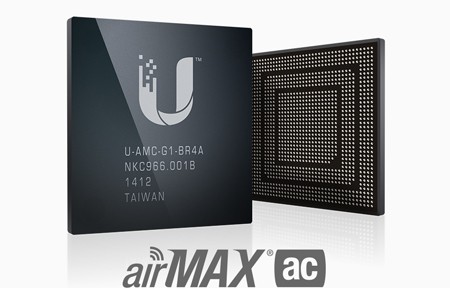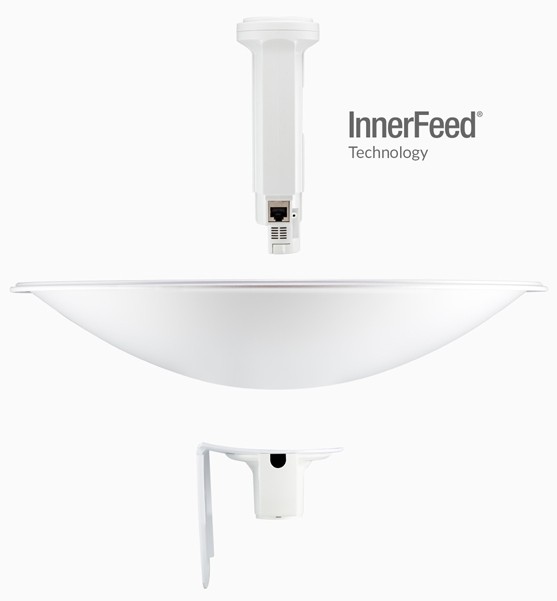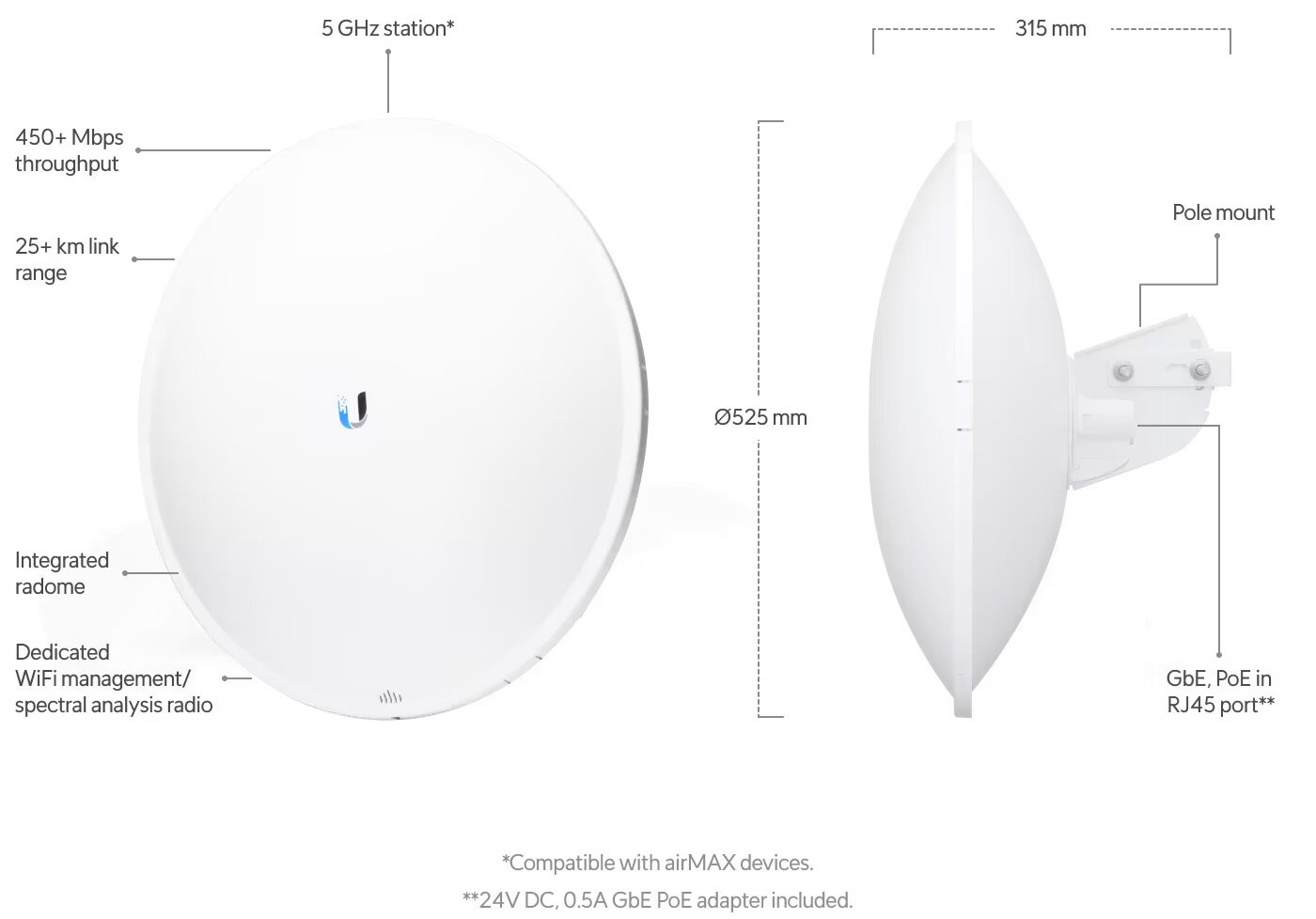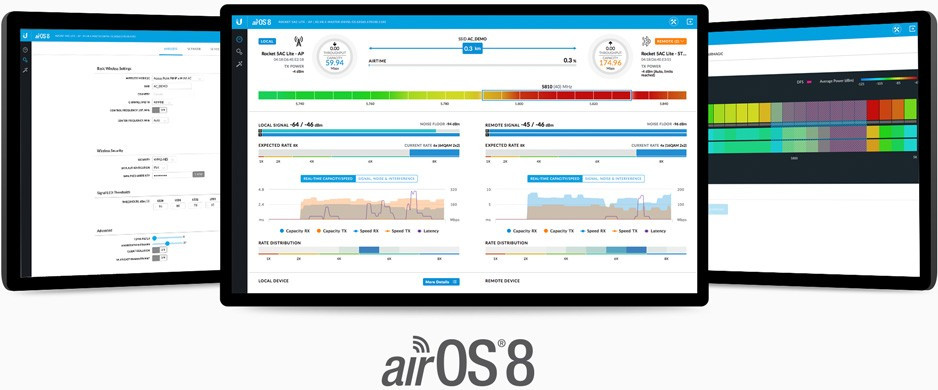5 GHz WiFi antenna with a 450+ Mbps Real TCP/IP throughput rate and 25+ km link range.
The airMAX PowerBeam 5AC 500 stands as a testament to Ubiquiti Networks' dedication to pushing the boundaries of wireless broadband technology. This device is specifically engineered to meet the demands of high-performance wireless networks, offering unparalleled connectivity for point-to-point (PtP) and point-to-multipoint (PtMP) configurations. Operating within the 5 GHz frequency band, the PowerBeam 5AC 500 utilizes Ubiquiti's proprietary airMAX ac technology to achieve significant improvements in throughput and signal integrity over long distances.

This product should be purchased in pairs in order to form links.
The PowerBeam 5AC 500 is specifically designed to work in conjunction with other airMAX ac devices. This includes various models of Ubiquiti’s outdoor wireless access points, bridges, and customer premises equipment (CPE) that also utilize airMAX ac technology. It's also important to consider, that while the PowerBeam 5AC 500 is optimized for the airMAX series, direct operational integration with the UniFi series, which is tailored for managed Wi-Fi networking within indoor and semi-outdoor environments and uses a different management system (UniFi Controller), is not its primary feature. The distinct operational frameworks and intended applications of the airMAX and UniFi series limit their direct interoperability.
At the core of the PowerBeam 5AC 500's capabilities is its integrated high-gain, 27 (dBi) dish antenna, boasting a diameter of 500 mm. This large reflector enables the device to focus the transmitted signal more precisely, significantly enhancing its directivity and ability to bridge over 25 km distances with minimal signal degradation. Such focused energy delivery is pivotal for maintaining high-quality, reliable wireless connections in diverse environments, from densely populated urban areas to remote rural locations.

Ubiquiti's airMAX ac technology, embedded within the PowerBeam 5AC 500, brings a host of advancements including superior modulation techniques and a Time Division Multiple Access (TDMA) protocol. These innovations allow for increased bandwidth efficiency, reduced latency, and improved network scalability by enabling more concurrent data transmissions. The result is a robust wireless link capable of supporting bandwidth-intensive applications, such as HD video streaming, VoIP communications, and large data transfers, without compromising on speed or reliability.

The device's design is meticulously crafted to ensure durability and ease of deployment. The PowerBeam 5AC 500 features a protective radome that shields the antenna from the elements, preserving signal clarity and prolonging the device's lifespan even in harsh weather conditions. The inclusion of a dedicated mounting bracket facilitates precise alignment and secure installation, allowing network operators to achieve optimal signal reception and transmission. Additionally, Ubiquiti’s InnerFeed® technology integrates the radio into the feedhorn of an antenna, so there is no need for cables to connect the radio to the antenna. This improves performance because it eliminates cable losses. The PowerBeam 5AC requires no tools for assembly; only a single wrench is required for pole-mounting.
Security features within the PowerBeam 5AC 500 are robust, incorporating WPA2 encryption to safeguard data transmissions against unauthorized access. This ensures that sensitive information remains protected, maintaining the integrity and confidentiality of the network.
Ease of management is another hallmark of the PowerBeam 5AC 500, enabled by Ubiquiti's intuitive airOS interface. This software provides a comprehensive suite of tools for device configuration, network monitoring, and performance optimization. From advanced RF analytics to real-time status reporting, airOS equips network administrators with the insights needed to fine-tune their wireless infrastructure for peak efficiency.
Choosing the right PowerBeam
Selecting the right PowerBeam product from Ubiquiti for your network involves a nuanced understanding of your specific needs and environmental conditions. Consider the frequency band: 2.4 GHz models like the PBE-2AC-400 and PBE-M2-400 are adept at penetrating obstacles and are suitable for medium-range deployments, while 5 GHz models, including PBE-5AC-Gen2, PBE-5AC-500, PBE-5AC-620, and PBE-5AC-ISO-Gen2, offer higher throughput and are ideal for clearer, longer-range links. The choice between these depends on the balance between range, throughput, and environmental factors such as urban / natural obstacles and interference.
Antenna size directly influences range and signal focus: larger dishes on the PBE-5AC-500 and PBE-5AC-620 support the longest distances, whereas the PBE-5AC-Gen2 provides versatile deployment options. The PBE-5AC-ISO-Gen2's enhanced noise isolation makes it perfect for high-interference environments. Lastly, deployment scenarios—whether seeking broad coverage for multiple locations or a focused beam for direct point-to-point links—will guide your selection. Budget considerations and future scalability also play crucial roles in determining the most cost-effective and performance-optimized choice for your wireless network infrastructure.
Compare with similar products
| | | | | | |
|---|
| Wireless Standard | |
| |
| 802.11ac
| 802.11ac
| 802.11ac
| 802.11ac
| 802.11ac
|
| 2.4GHz Radio Rate | |
| |
| 450 Mbps
| 450 Mbps
|
|
| 450 Mbps
|
| 5GHz Radio Rate | |
| |
|
| 450 Mbps
| 450 Mbps
|
|
| Wireless Antenna Frequency Range & Gain | |
| |
| 5.150 - 5.875 (GHz) 27 (dBi)
| 2.412 - 2.472 (GHz) 18 (dBi)
| 5.150 - 5.875 (GHz) 25 (dBi)
| 5.150 - 5.875 (GHz) 25 (dBi)
| 5.150 - 5.875 (GHz) 29 (dBi)
|
| Antenna range | |
| |
| 25 km
| 25 km
| 15 km
| 15 km
| 25 km
|
| Ethernet Ports | |
| |
| 1 x 1 Gbps
| 1 x 1 Gbps
| 1 x 1 Gbps
| 1 x 1 Gbps
| 1 x 1 Gbps
|
| Chipset | |
| |
| Atheros MIPS 74Kc, 720 MHz
| MIPS 74Kc
| MIPS 74Kc
| MIPS 74Kc
| Atheros MIPS 74Kc, 720 MHz
|
| RAM | |
| |
| 128 MB
| 64 MB
| 64 MB
| 64 MB
| 128 MB
|
| Storage Memory | |
| |
| 16 MB
|
|
|
| 16 MB
|
| Max Power Consumption | |
| |
| 8.5 W
| 7.5 W
| 8.5 W
| 8.5 W
| 8.5 W
|
| Weight | |
| |
| 3.15 kg
| 1.795 kg
| 3.22 kg
| 2.22 kg
| 6.4 kg
|
| | | | | | |
|---|
| Wireless Standard | 802.11ac
| 802.11ac
| 802.11ac
| 802.11ac
| 802.11ac
|
| 2.4GHz Radio Rate | 450 Mbps
| 450 Mbps
|
|
| 450 Mbps
|
| 5GHz Radio Rate |
|
| 450 Mbps
| 450 Mbps
|
|
| Wireless Antenna Frequency Range & Gain | 5.150 - 5.875 (GHz) 27 (dBi)
| 2.412 - 2.472 (GHz) 18 (dBi)
| 5.150 - 5.875 (GHz) 25 (dBi)
| 5.150 - 5.875 (GHz) 25 (dBi)
| 5.150 - 5.875 (GHz) 29 (dBi)
|
| Antenna range | 25 km
| 25 km
| 15 km
| 15 km
| 25 km
|
| Ethernet Ports | 1 x 1 Gbps
| 1 x 1 Gbps
| 1 x 1 Gbps
| 1 x 1 Gbps
| 1 x 1 Gbps
|
| Chipset | Atheros MIPS 74Kc, 720 MHz
| MIPS 74Kc
| MIPS 74Kc
| MIPS 74Kc
| Atheros MIPS 74Kc, 720 MHz
|
| RAM | 128 MB
| 64 MB
| 64 MB
| 64 MB
| 128 MB
|
| Storage Memory | 16 MB
|
|
|
| 16 MB
|
| Max Power Consumption | 8.5 W
| 7.5 W
| 8.5 W
| 8.5 W
| 8.5 W
|
| Weight | 3.15 kg
| 1.795 kg
| 3.22 kg
| 2.22 kg
| 6.4 kg
|
Technical Specs / Datasheet

 Ubiquiti's airMAX ac technology, embedded within the PowerBeam 5AC 500, brings a host of advancements including superior modulation techniques and a Time Division Multiple Access (TDMA) protocol. These innovations allow for increased bandwidth efficiency, reduced latency, and improved network scalability by enabling more concurrent data transmissions. The result is a robust wireless link capable of supporting bandwidth-intensive applications, such as HD video streaming, VoIP communications, and large data transfers, without compromising on speed or reliability.
Ubiquiti's airMAX ac technology, embedded within the PowerBeam 5AC 500, brings a host of advancements including superior modulation techniques and a Time Division Multiple Access (TDMA) protocol. These innovations allow for increased bandwidth efficiency, reduced latency, and improved network scalability by enabling more concurrent data transmissions. The result is a robust wireless link capable of supporting bandwidth-intensive applications, such as HD video streaming, VoIP communications, and large data transfers, without compromising on speed or reliability.

Reviews and ratings
Product rating